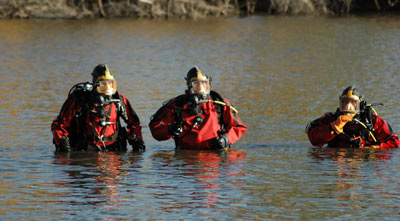What Diver Rescue Personnel Need to Know
Dangers that rescue personnel may face in and around flood water, still water, moving water, swift water, whitewater and low water.

In the Colorado River basin, rescue personnel train for high water conditions. These conditions pose many challenges, including high risk swift water, massive and powerful hydraulic forces and bank erosion, which ultimately lead to downed trees.
On the contrary, with low water volumes, additional dangers arise to include limb entrapments and entanglement issues. When experiencing high water, many obstructions are covered up, with low water many of those obstructions appear and cause greater danger to recreational rafters and rescue personnel.
On all rescue operations, we employ a low to high risk rescue technique and sequence. The typical rescue sequence is: Talk, Reach, Throw, Row, Go and lastly Helo.
So let’s talk about what we should do as rescuers. Awareness and Prevention are key when approaching low water foot entrapments.
We have to be aware that in low water environments the potential for entrapment increases dramatically. Then we should consider where most entrapment issues occur: near the shore on both sides of the river and also in and around islands that often appear during periods of low water.
So what should we do to prevent foot entrapment? We should NEVER stand up in water that is over ankle deep, especially in moving water. We teach our personnel to NEVER stand until feet are firmly planted on the shore. You should swim into the shore, typically using a crawl stroke. We then recommend using the dog crawl method to the shore until you are firmly planted before standing. (Dog crawl- hands and knees, using all four)
We also teach the “safe eddy rule.” The safe eddy rule states: do not attempt to stand until you have reached a safe eddy. Even then, we still observe the ankle deep guideline.
So you now have a victim that has a foot entrapped. What can we do? Ultimately, the safest and most effective way to free the victim would be to pull the foot out the way it went in. Our PSDS saiche weight system and an effective PSDS net extraction system. These systems allow rescue personnel to place the extrication line in the water to the entrapped area for potential foot extrication. Before you can deploy PSDS saiche weight system or PSDS net system, you must first deploy a stabilization line. This offers your victim something to brace against and to ultimately help maintain their airway. Without an airway it is now a recovery. Please note, there are other more complex systems available.
Another factor that needs to be considered when deploying a system that is designed to drop through the water column is the speed of the water. Simply stated, with greater water speed you will need to use a greater amount of weight in order to get your system to the bottom near the entrapped area.
The moral of the story is, just because the water is lower and maybe slower it does not mean it is any safer. An additional moral would be that teams should practice for all conditions low and high water and recognize and assess the risk associated with both.
For more information on the ERDI Swift Water Level one course, visit https://www.tdisdi.com/erdi/ or contact your local ERDI Dive Center.
Bo Tibbetts is a regular contributor to the ERDI articles as well as assists with the development of ERDI standards. Bo owns and operates Public Safety Dive Services Academy.
Click here for more details about ERDI >
Contact ERDI
If you would like more information about ERDI, please contact:
ERDI
Tel: 888.778.9073 | 207.729.4201
Email: Worldhq@tdisdi.com
Web: https://www.tdisdi.com
Facebook: www.facebook.com/PublicSafetyDiving


Plaats een Reactie
Meepraten?Draag gerust bij!